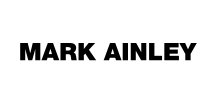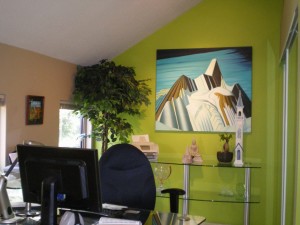With all the focus put on creative designs for homes, work spaces are often overlooked. The functional needs of an office often leads to neglecting the many potential options for streamlining it both aesthetically and functionally. I like to put the ‘function’ in Feng Shui and ensure that a space is aligned decoratively and pratically. When an office feels ‘right’, you can work with greater efficiency and calm.
The old adage of ‘location, location, location’ for business success applies to how you orient yourself inside your work space too. There’s a reason cowboys in the Wild West didn’t want to sit with their backs to the door, something apparently considered by today’s mafia bosses: you leave yourself open to being backstabbed. You will never see a successful company president sitting with their desk up against a wall and their back to the door; such a position translates into feeling overwhelmed, unprepared for what is coming your way (because you can’t see it), and feeling bent out of shape when interruptions present themselves.
By contrast, the ‘executive position’ or ‘seat of power’ – with the desk facing into the room and its occupant facing the door, ideally with a windowless wall behind them – supports clear vision of approaching circumstances (ie anyone entering your space), a sense of support (from the wall behind), and the ability to sustain connection to work and changing circumstances (looking at your desk while being aware when someone comes into the room). Your nervous system is calmer and you can therefore focus much more clearly when your body is aware that no potential threats can approach you from behind. If you are unable to sit in this position, do your best to get a high-backed chair for support and a reflective object in front of you so that you can catch glimpses of what is happening behind you.
There’s a reason businesses and companies can be referred to as ‘organizations’ – how they are structured for efficiency can determine their success. Similarly, the space you work in needs to be well organized if you are to do your job well. (This shouldn’t be a surprise, but if you saw some of the offices I see…) It is important that you have easy access to what you need to do your job well. If your papers are a mess or you can’t find your stapler, you will subconsciously want to avoid any tasks involving those items. If you have to bend uncomfortably to reach for certain items, that physical awkwardness will leave you more inclined to go grab a coffee than to do your job. Keep in mind that cluttered surfaces represent blocked creativity that can prevent you from reaching your desired destinations. Create a system for keeping paper under control: this means daily and weekly organization time, but it will save you time in the long run. I also suggest avoiding trays on which papers are kept horizontal, as the single paper on top obscures the rest, which is incredibly inefficient. A compact box with hanging files is much more practical, making it possible to create many sub-categories and easily put your hands on what you need.
Office spaces generally use fluorescent bulbs – usually to save money – yet these light sources are counterproductive in other ways. They are not full-spectrum and therefore don’t cast a shadow, thus limiting depth perception; this translates into a reduced capacity to think deeply and see long-term. While it may be that some old-school companies prefer that employees be less observant and more obedient, I believe that empowering workers to see and think to their full capacity will serve everyone’s best interests. If you cannot change the primary lighting sources in your office or work space at home, consider adding a small lamp on your desk so that you can illuminate your projects with a more integrated source of light.
Adding colour – there is a great variety of file folders and other organizational tools in myriad hues – will help to bring a fuller spectrum of possibility in your work space. While functionality is of prime importance, a workplace that is devoid of personal touches will prevent employees from putting their heart into their job. However, how you do this is important. There are too many motivational posters with insipid quotes that are meant to inspire you, but they reek of corporate servitude and sentiment, while on the other end of the spectrum, images of beaches or other exotic destinations where you are not currently sitting do little to encourage you to be present with the tasks at hand. It has been found that employees who have a say in decorating their spaces are far more productive and motivated, so aim to find a balance with inspiring images that do not necessarily involve sunny destinations.
May your workspace inspire you to do and be your best in all you do.



Recent Comments